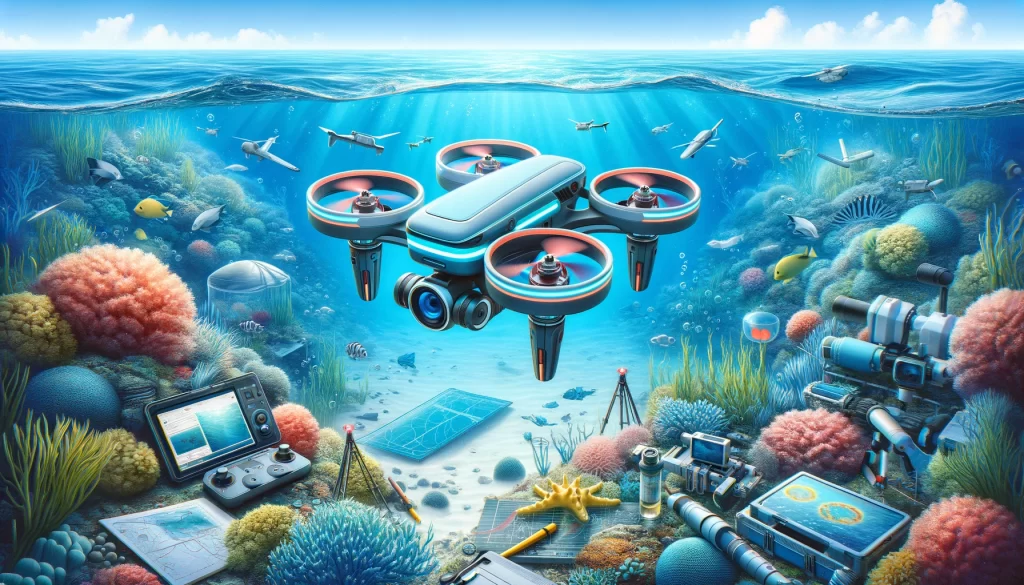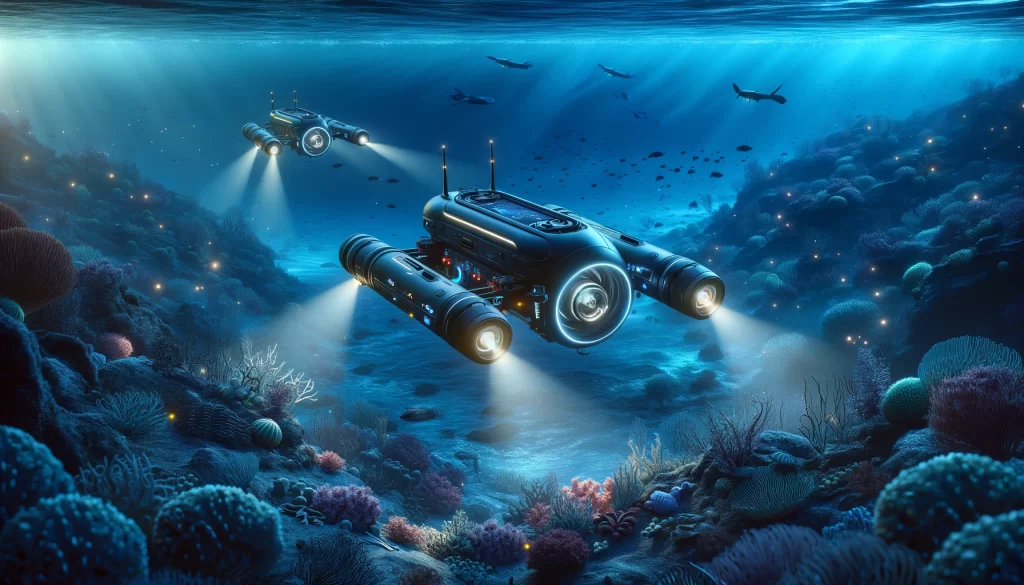In recent years, the world beneath the waves has become increasingly accessible, not just to scientists and commercial explorers but to a broader audience of hobbyists and enthusiasts. This shift is largely thanks to the advent and rising popularity of Personal Remotely Operated Vehicles (ROVs). These compact, sophisticated machines offer a window into the deep, allowing users to navigate underwater environments from the comfort of the surface. Personal ROVs, equipped with cameras and sometimes manipulative tools, have democratized ocean exploration, making it feasible for non-professionals to glimpse the mysteries of the deep firsthand.
The evolution of ROVs from bulky, expensive equipment reserved for professional use to more accessible, user-friendly devices has been remarkable. Technological advancements have played a pivotal role in this transformation, with miniaturization, increased battery efficiency, and enhanced camera technology making these devices both affordable and capable. What was once the domain of research institutions and commercial operations has expanded to include amateur marine biologists, underwater photography enthusiasts, and conservationists, among others.
The purpose of this post is to delve into the expanding world of personal ROVs, exploring their diverse applications across various domains. From the reefs explored by hobbyists to the undersea cables inspected by professionals, personal ROVs are making significant impacts. We’ll examine how these tools are not only fostering a greater appreciation of our marine ecosystems but are also playing crucial roles in scientific research, commercial operations, and conservation efforts. As we chart the prospects of personal ROVs, we aim to illuminate the potential these devices hold for furthering our understanding and stewardship of the ocean’s depths.
The Rise of Personal ROVs
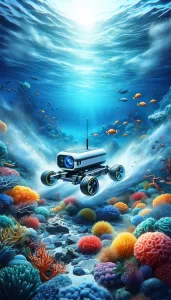 The journey of Remotely Operated Vehicles (ROVs) from niche, professional tools to widely accessible instruments for hobbyists and enthusiasts is a fascinating tale of technological evolution and democratization. Initially developed in the mid-20th century for industrial and scientific applications, such as underwater pipeline inspection and deep-sea exploration, ROVs were once the exclusive domain of organizations with significant resources. These early ROVs were large, complex, and required extensive support teams to operate, limiting their use to commercial and research institutions.
The journey of Remotely Operated Vehicles (ROVs) from niche, professional tools to widely accessible instruments for hobbyists and enthusiasts is a fascinating tale of technological evolution and democratization. Initially developed in the mid-20th century for industrial and scientific applications, such as underwater pipeline inspection and deep-sea exploration, ROVs were once the exclusive domain of organizations with significant resources. These early ROVs were large, complex, and required extensive support teams to operate, limiting their use to commercial and research institutions.
Historical Context
The origins of ROVs can be traced back to the 1960s, with their initial use in deep-sea rescue operations and oceanographic research. The development was propelled by the need to perform tasks in environments that were too risky or unreachable for human divers. Over the decades, these vehicles became indispensable for various underwater tasks, including the maintenance of offshore oil and gas fields, scientific exploration, and military applications. However, their complexity, size, and cost kept them out of reach for individual enthusiasts and small-scale researchers.
Technological Democratization
The transition from these early models to the compact, versatile, and affordable ROVs we see today is a testament to the rapid advancements in technology. Miniaturization of electronics, improvements in battery technology, and advancements in materials science have all played pivotal roles in this transformation. Modern personal ROVs are equipped with high-definition cameras, efficient propulsion systems, and intuitive control interfaces, making them not only more accessible but also user-friendly for a broader audience. This democratization of technology has opened up the underwater world to hobbyists, educators, and citizen scientists, enabling them to explore and document the marine environment like never before.
Market Growth
The growth of the personal ROV market reflects this increased accessibility and interest. According to a report by Grand View Research, the global ROV market size, which includes both industrial and personal use ROVs, was valued at USD 3.97 billion in 2019 and is expected to expand at a compound annual growth rate (CAGR) of 11.8% from 2020 to 2027. This growth is partly driven by the rising interest among hobbyists and the expanding applications of ROVs in environmental monitoring, archaeological surveys, and educational uses. Social media and crowdfunding platforms have further fueled this trend, enabling small companies and startups to bring innovative and affordable ROVs to the market.
The rise of personal ROVs represents a significant shift in how we interact with and explore the marine environment. As technology continues to advance, we can expect these tools to become even more capable, further lowering the barriers to underwater exploration and opening up new possibilities for discovery and conservation.
Technical Specifications and Capabilities
 The burgeoning world of personal Remotely Operated Vehicles (ROVs) is characterized by an impressive array of technical specifications and capabilities, making these devices not just tools for exploration but also marvels of modern engineering. Personal ROVs have evolved to offer functionalities once reserved for their professional counterparts, albeit in more compact and user-friendly packages.
The burgeoning world of personal Remotely Operated Vehicles (ROVs) is characterized by an impressive array of technical specifications and capabilities, making these devices not just tools for exploration but also marvels of modern engineering. Personal ROVs have evolved to offer functionalities once reserved for their professional counterparts, albeit in more compact and user-friendly packages.
Design and Build
The design and build quality of personal ROVs are pivotal to their performance and durability in challenging underwater environments. Most personal ROVs feature a robust, waterproof chassis made from corrosion-resistant materials such as high-grade plastics or lightweight metals, enabling them to withstand the harsh saltwater environment. Waterproofing is achieved through meticulous sealing and pressure-resistant casings, ensuring electronic components remain dry and functional, even when navigating deep waters. Pressure resistance is another critical design consideration, with many models capable of descending to depths of 100 meters or more, subject to the limitations of their build and purpose.
Mobility is facilitated through a combination of thrusters and buoyancy control systems, allowing for agile movement in three-dimensional space. These ROVs are typically equipped with at least four thrusters, enabling forward/reverse movement, vertical descent/ascent, and 360-degree turns. This mobility is crucial for navigating the complex terrain of the ocean floor, dodging obstacles, and conducting detailed inspections or explorations.
Advanced Features
Advancements in technology have endowed personal ROVs with features that enhance their utility and performance. High-definition (HD) cameras are standard, offering users crystal clear views of the underwater world, essential for detailed inspections, scientific research, and capturing breathtaking imagery. Many models also include LED lighting systems to illuminate the dark depths of the ocean, improving camera visibility and user experience.
In addition to visual capabilities, some personal ROVs come equipped with robotic arms and a variety of sensors. Robotic arms allow for interaction with the environment, such as collecting samples or manipulating objects, while sensors can measure environmental parameters like temperature, depth, and water chemistry, adding a scientific research dimension to their use.
Comparison with Professional Models
While personal ROVs have made significant strides in capabilities, there remain distinctions between them and professional models. Professional ROVs often have greater depth capabilities, and advanced navigation systems, and can carry a wider array of tools and instruments. They are designed for prolonged use in extreme conditions and can perform more complex tasks such as heavy lifting or precise manipulations requiring high levels of force or dexterity.
However, the gap between personal and professional ROVs continues to narrow with each technological advancement. Personal ROVs now offer a remarkable range of functionalities, bringing the deep sea’s mysteries within reach of a broader audience. This democratization of underwater exploration technology is not just a testament to human ingenuity but also a promise of the untapped potential that lies beneath the waves, waiting to be discovered by anyone equipped with a personal ROV.
Applications Across Domains
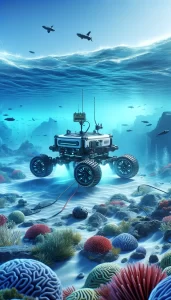 The advent of personal Remotely Operated Vehicles (ROVs) has ushered in a new era of underwater exploration and utility, stretching across recreational, scientific, and commercial domains. These compact, versatile machines have opened the ocean’s depths to a broader audience, enabling a range of activities that were previously the preserve of well-funded professional endeavors.
The advent of personal Remotely Operated Vehicles (ROVs) has ushered in a new era of underwater exploration and utility, stretching across recreational, scientific, and commercial domains. These compact, versatile machines have opened the ocean’s depths to a broader audience, enabling a range of activities that were previously the preserve of well-funded professional endeavors.
Recreational Exploration
For hobbyists and marine enthusiasts, personal ROVs have transformed the landscape of underwater exploration. With these devices, individuals can embark on adventures right from the shoreline or their boats, diving into the mysteries of the deep without getting wet. Underwater photography, once a challenging endeavor requiring expensive equipment and diving expertise, is now accessible to many. ROVs equipped with high-definition cameras allow for stunning visual documentation of marine life, coral reefs, and underwater landscapes. Wreck diving, a fascination for many, becomes a less hazardous pursuit with ROVs, enabling explorers to survey and document sunken ships and aircraft without the risks associated with deep dives. Moreover, the observation of marine life in its natural habitat, without the disturbance that human presence often causes, offers invaluable insights into the behavior and diversity of underwater ecosystems.
Scientific Research
In the realm of scientific research, personal ROVs serve as pivotal tools for marine biologists, oceanographers, and environmental scientists. These ROVs facilitate detailed studies of marine biology, allowing researchers to observe and document species and habitats that are difficult or impossible to access otherwise. Environmental monitoring, crucial in the age of climate change, benefits from the deployment of ROVs to assess the health of marine ecosystems, track changes over time, and gather data on water quality, temperature, and pollution levels. Furthermore, personal ROVs enable efficient data collection, supporting a wide range of scientific inquiries from the study of coral bleaching to the effects of underwater seismic activity.
Commercial and Industrial Use
Beyond recreation and research, personal ROVs find application in commercial and industrial settings. Small businesses and professionals in fields such as marine construction, aquaculture, and underwater maintenance have adopted these tools for various tasks. Underwater inspection and maintenance of structures like piers, bridges, and offshore platforms are made more manageable and less risky with ROVs. These devices can perform detailed inspections in murky or confined waters where human divers might face significant challenges. Additionally, in the realm of marine surveying and mapping, personal ROVs contribute to the accurate charting of seabeds and the identification of hazards, facilitating safer navigation and informed decision-making for marine operations.
Across these domains, the versatility and advanced capabilities of personal ROVs stand out, highlighting their growing importance in unlocking the ocean’s potential for enthusiasts, researchers, and professionals alike.
Challenges and Limitations
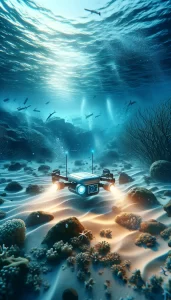 The widespread adoption and utility of personal Remotely Operated Vehicles (ROVs) in exploring the underwater realm come with their set of challenges and limitations. On the technical front, users frequently encounter issues related to battery life, depth capabilities, and navigation. The finite battery life of personal ROVs limits the duration of underwater expeditions, necessitating careful planning to maximize exploration while managing power consumption. Depth limitations, dictated by the design and build quality of the ROV, restrict access to deeper marine environments, confining users to relatively shallow dives. Furthermore, navigating strong ocean currents presents a significant challenge, as these can impede the ROV’s mobility and stability, affecting its ability to collect data or capture high-quality imagery.
The widespread adoption and utility of personal Remotely Operated Vehicles (ROVs) in exploring the underwater realm come with their set of challenges and limitations. On the technical front, users frequently encounter issues related to battery life, depth capabilities, and navigation. The finite battery life of personal ROVs limits the duration of underwater expeditions, necessitating careful planning to maximize exploration while managing power consumption. Depth limitations, dictated by the design and build quality of the ROV, restrict access to deeper marine environments, confining users to relatively shallow dives. Furthermore, navigating strong ocean currents presents a significant challenge, as these can impede the ROV’s mobility and stability, affecting its ability to collect data or capture high-quality imagery.
Regulatory hurdles also pose a constraint on the use of personal ROVs. Legal and regulatory frameworks governing marine and coastal environments can vary widely by jurisdiction, sometimes restricting the deployment of ROVs in protected areas, near critical infrastructure, or in zones with heavy maritime traffic. These regulations are often instituted to protect marine ecosystems, preserve archaeological sites, and ensure the safety of maritime activities, but they can also limit the scope of exploration and research accessible to hobbyists and professionals alike. Navigating these technical and regulatory challenges is essential for the effective and responsible use of personal ROVs in underwater exploration.
Future Trends and Innovations
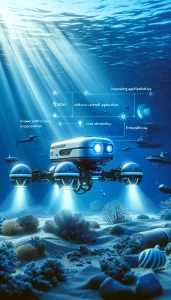 The horizon for personal Remotely Operated Vehicles (ROVs) is replete with promising technological advancements and expanding applications, poised to redefine underwater exploration and utility. Future iterations of personal ROVs are expected to benefit significantly from enhanced autonomy, integrating more sophisticated artificial intelligence (AI) algorithms. This leap forward will not only improve navigation and decision-making in complex underwater environments but also enable these devices to undertake more intricate tasks independently, such as environmental monitoring and archaeological site mapping.
The horizon for personal Remotely Operated Vehicles (ROVs) is replete with promising technological advancements and expanding applications, poised to redefine underwater exploration and utility. Future iterations of personal ROVs are expected to benefit significantly from enhanced autonomy, integrating more sophisticated artificial intelligence (AI) algorithms. This leap forward will not only improve navigation and decision-making in complex underwater environments but also enable these devices to undertake more intricate tasks independently, such as environmental monitoring and archaeological site mapping.
AI integration will likely be accompanied by substantial improvements in battery technology. Developments in energy storage, such as higher-density batteries and more efficient charging solutions, will extend the operational time of ROVs, allowing for longer and deeper dives. This advancement will expand the scope of exploration and data collection capabilities, making personal ROVs even more versatile tools for scientific research, conservation efforts, and recreational exploration.
Moreover, the expanding applications of personal ROVs are set to open new avenues for innovation and entrepreneurship. Beyond traditional uses, we may see these devices being deployed for underwater infrastructure inspection, search and rescue operations, and even in the emerging field of underwater tourism. The versatility and accessibility of personal ROVs will encourage entrepreneurial ventures, fostering a new ecosystem of services, software, and accessories tailored to enhance the capabilities and user experience of these underwater explorers.
Conclusion
The evolution of personal Remotely Operated Vehicles (ROVs) marks a significant milestone in the democratization of underwater exploration. Transitioning from professional to hobbyist’s hands, these advanced machines have opened up the deep seas to a wider audience, enabling discoveries and insights that were once the preserve of a select few. From capturing the unseen beauty of underwater realms to conducting critical scientific research and supporting commercial operations, personal ROVs have proven their invaluable versatility and potential.
As we stand on the brink of new technological advancements and expanding applications, there’s an open invitation to everyone—hobbyists, researchers, and entrepreneurs alike—to dive into the fascinating world of personal ROVs. Engage with this emerging technology to explore, discover, and innovate, contributing to the ongoing exploration and understanding of our planet’s final frontier: the ocean.

